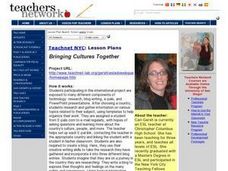Curated OER
The Froggy Page
Students investigate the cycle of life by observing tadpoles. In this biology lesson, students utilize the Internet to read stories, observe pictures, and listen to sounds of frogs. Students create a poster board collage using frog...
Curated OER
Playground Safety
Students conduct experiments with fruit falling from playground equipment to explain the effects of falling off playground equipment.
Curated OER
A Gesture Is Worth a Thousand Words
Learners share observations on the nuances of meaning in face to face and online interactions with others. After reading an article, they identify the causes and effects of internet flaming. They create their own comic strips...
Curated OER
Communicating through Engineering Information Technology
Students analyze prior labs by keeping a lab notebook. They share their lab notebook by electronically sending it to their classmates. Students demonstrate evaluation of other lab notebooks within the same classroom and those from other...
Curated OER
Viruses Released
Seventh graders assume different roles to determine the cause of a possible virus outbreak in their school. They must investigate the symptoms reported and determine the virus causing these conditions, analyze the body systems affected...
Curated OER
The Digestive And Urinary Systems
In this digestive and urinary systems activity, students solve 4 puzzles or riddles, They complete anagrams, chose the odd one out and use clues to solve a digestive tract riddle.
Curated OER
A New Spin on Letter Writing Lessons
Letter writing lessons can provide a way to introduce students to this important mode of communication.
Curated OER
Bringing Cultures Together
High schoolers research specific information for the United Nations and present them in a PowerPoint presentation. They connect with another student in in their country of research by emailing them. They create a blog of creative writing...
Curated OER
Kindergarten Exploration Tubs
Students identify their names as a symbol for themselves. They describe characteristics of organisms. They utilize tools to gather data and compare size.
Curated OER
Political Parties and Election Results, 1997 and 2000
Young scholars become familiar with the results of the Canadian Federal Election by analyzing data on the number of valid votes by political affiliation. In this civics lesson plan, students integrate data and knowledge with other...
Curated OER
Le Grand Voyage
Eighth graders work in collaborative groups to research a country of their choosing. Groups use the internet to their country and plan a trip to that location. Students complete a multi-media presentation of their country, following a...
Curated OER
Literature: Watching Anna
Students view the PBS presentation of Leo Tolstoy's, "Anna Karenina." Prior and after each episode, they discuss plot and characterization and in one lesson, use adjectives to describe each of the main characters. Then, students create...
Curated OER
The Korean War
Students examine the implications of the Korean War. In this Korean War lesson, students access the Korean War website to gain access to veterans of the war that they may interview. Students conduct interviews with veterans and create...
Curated OER
Monsters, Monsters, Monsters
Students are introduced to how to use the internet and send emails. In groups, they work together to send emails to other students around the world. To end the instructional activity, they read their emails to the class and respond to...
Curated OER
Sliding Along
Third graders explore the concept of linear measurements and how they work. Coins are used to reinforce the process.
Curated OER
Fossil Formation Fun
Students compare the three types of fossils: preserved organisms, mineral replacement fossils, and impression fossils. They create a model of amber,
sponge fossil, and make traces of fossil.
Curated OER
Where Do Things Come From?
Second graders examine the recycling process. In this recycling lesson, 2nd graders discuss the reasons for recycling and create storyboards to show where a specific material comes from. Students complete a worksheet as a follow-up...
Curated OER
Media Literacy: TV - What You Don't See!
Students examine how to evaluate what they are watching on television. They discuss hip hop music videos, compare/contrast them to other types of music videos, write a letter or press release about promoting positive teen stories, and...
Curated OER
Flying Against The Wind
Eighth graders discuss the various actions of non-Jewish Germans during World War II. Through various readings and activities, they explore the rejection of Nazi ideology and how many German citizens worked to help Jewish citizens during...
Curated OER
What Did I Touch Today?
Young scholars investigate germs and how they travel. They graph the places in the classroom that have been touch by students to determine which five places have had the most contact. They write stories from a germ's point of view.
Curated OER
Text Structures in Science Writing
Students recognize that science writing is organized in identifiable patterns called text structures. Understanding and using these different text structures help refine students' abilities to read and write in science.
Curated OER
Anne Frank: Critical Thinking
Students read a story by James Clavell about propaganda and they discuss how it was used in the story. In groups, they decide what they would do if faced with certain situations.
Utah Education Network (UEN)
Balanced Diet
Second graders investigate the concept of a balanced diet and how the food pyramid is organized. They conduct research using the links included in the instructional activity. They differentiate the parts of the pyramid while looking at...
Curated OER
Equivalent Decimals
Young scholars develop strategies to find equivalent decimals. In this equivalent decimals lesson, students participate in a variety of decimal games to find equivalent decimals.

























